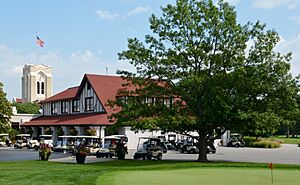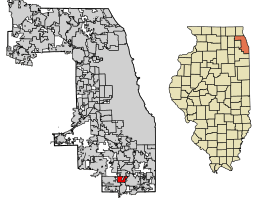Olympia Fields, Illinois facts for kids
Quick facts for kids
Olympia Fields, Illinois
|
||
|---|---|---|

|
||
|
||
| Motto(s):
Where People Make the Village
|
||

Location of Olympia Fields in Cook County, Illinois.
|
||
| Country | United States | |
| State | Illinois | |
| County | Cook | |
| Township | Bloom, Rich | |
| Founded | 1927 | |
| Government | ||
| • Type | Village | |
| Area | ||
| • Total | 2.94 sq mi (7.62 km2) | |
| • Land | 2.94 sq mi (7.61 km2) | |
| • Water | 0.00 sq mi (0.01 km2) | |
| Population
(2020)
|
||
| • Total | 4,718 | |
| • Density | 1,605.31/sq mi (619.90/km2) | |
| Time zone | UTC-6 (CST) | |
| • Summer (DST) | UTC-5 (CDT) | |
| ZIP Code(s) |
60461
|
|
| Area code(s) | 708 | |
| FIPS code | 17-55938 | |
| Wikimedia Commons | Olympia Fields, Illinois | |
Olympia Fields is a village located in Cook County, Illinois, United States. It's a southern suburb of Chicago. In 2020, about 4,718 people lived there. The village grew around the famous Olympia Fields Country Club, which started in 1915.
Olympia Fields is known for being a community where many people have college degrees and good incomes. It has one of the highest rates of homeownership among communities with a majority African-American population in the country.
Contents
History of Olympia Fields
The land where Olympia Fields now stands was once farmland in the 1830s. Immigrant families worked these farms. In the 1850s, the Illinois Central Railroad started serving the area. This helped the community grow and become more active.
In 1893, a big event called the Columbian Exposition happened in Chicago. This made southern Cook County a popular place for Chicagoans to relax. By 1913, a group of investors, led by Charles Beach, decided to build a golf course there. They loved the area's beautiful woodlands and rolling hills.
Beach and his friend James Gardner created a huge 72-hole golf course and country club. It was officially started in 1915 as the Olympia Fields Country Club. Amos Alonzo Stagg, a famous football coach, became its first president. He suggested the name "Olympia." The word "Fields" was added because it described the area's open, natural landscape.
In the early 1900s, golf and the resort feel south of Chicago became very popular. Some families even lived in canvas "cottages" during the summer. Others started building permanent homes around 1919. The clubhouse, built in 1924, is now on the National Register of Historic Places. The golf course is considered one of the best in the nation. It has hosted many major golf tournaments, including the U.S. Open in 1928 and 2003.
Charles Beach, the founder of the country club, also helped create the Village of Olympia Fields in 1927. He became its first president. His old home, which looks like the Country Club, is still standing today. The Country Club itself is not part of the village government.
Olympia Fields has won the Tree City USA award many times. This award recognizes communities that care for and manage their public trees well.
Geography of Olympia Fields
Olympia Fields is located at 41°31′6″N 87°41′34″W / 41.51833°N 87.69278°W. It covers an area of about 2.94 square miles (7.62 square kilometers). Most of this area is land, with only a tiny bit of water.
Population and People
| Historical population | |||
|---|---|---|---|
| Census | Pop. | %± | |
| 1930 | 143 | — | |
| 1940 | 101 | −29.4% | |
| 1950 | 160 | 58.4% | |
| 1960 | 1,503 | 839.4% | |
| 1970 | 3,478 | 131.4% | |
| 1980 | 4,146 | 19.2% | |
| 1990 | 4,248 | 2.5% | |
| 2000 | 4,732 | 11.4% | |
| 2010 | 4,988 | 5.4% | |
| 2020 | 4,718 | −5.4% | |
| U.S. Decennial Census 2010 2020 |
|||
In 2020, Olympia Fields had 4,718 residents. There were 1,960 households in the village. About 24.4% of these households had children under 18 living with them. The average household had about 3.43 people.
The population includes people of various backgrounds. About 78% of the residents were African American, and 15% were White. A small percentage of residents were Asian, Native American, or from other racial groups. About 3% of the population identified as Hispanic or Latino.
The median age in the village was 46.7 years old. This means half the people were younger than 46.7, and half were older.
Getting Around Olympia Fields
The Village of Olympia Fields is easy to reach. It's located between Vollmer Road and US Route 30 (Lincoln Highway). It's also just two miles east of Interstate 57.
You can travel by train using the Metra Electric Main Line. There are two stations in Olympia Fields: the Olympia Fields station and the 211th Street (Lincoln Highway) station. These trains can take you to downtown Chicago and the University of Chicago in about 40 minutes. Both stations have parking available.
Pace also provides bus service on Route 357. This bus connects Olympia Fields to other places in the Southland area.
Education in Olympia Fields
Students in Olympia Fields attend several different public school districts. This can be a bit confusing because where you live in the village determines which schools you go to!
Most students start at Arcadia Elementary School in Olympia Fields for kindergarten through third grade. After that, they might go to Indiana School (grades 4-6) in Park Forest, and then O.W. Huth Middle School (grades 7-8) in Matteson. For high school, most attend Rich Central High School in Olympia Fields.
However, students from certain neighborhoods, like Graymoor and The Greens, attend schools in Flossmoor. Students from the Wysteria neighborhood go to schools in Chicago Heights.
In total, students from Olympia Fields attend six different public school districts.
- Homewood-Flossmoor High School is a great school that has won the U.S. Department of Education's Blue Ribbon Award three times for its excellence. It even has its own high-powered radio station, WHFH 88.5!
- Southland College Preparatory Charter High School is a public charter school for grades 9-12. It has a longer school day, from 8 a.m. to 5 p.m., focusing on a strong college prep program with lots of math, science, technology, language, and arts.
Nearby Private Schools
There are also private school options close to Olympia Fields:
- Marian Catholic High School is a high school in Chicago Heights.
- Infant Jesus of Prague School is a K-8 Catholic school in Flossmoor, which has also won the Blue Ribbon Award twice.
- Church of the Nazarene Nursery School and Kindergarten offers programs for young children.
Colleges and Universities
For higher education, there are several colleges and universities nearby:
- Prairie State College in Chicago Heights offers associate degrees.
- Governors State University is also a short drive away, offering many different programs.
- Other colleges like Joliet Junior College, South Suburban College, and Trinity Christian College are also in the area. Plus, it's easy to get to the many universities in Chicago by train.
Notable People from Olympia Fields
Many interesting people have lived in Olympia Fields:
- Lou Boudreau – A famous baseball player who is in the Baseball Hall of Fame.
- Dee Dee Davis – An actress and comedian, known for The Bernie Mac Show.
- Kendall Gill – A retired professional basketball player.
- Toi Hutchinson – A member of the Illinois Senate.
- Rudolph Isley – A singer-songwriter and a founding member of The Isley Brothers band.
- J. Ivy – A poet who won a Grammy Award.
- Robert L. Martin – A Tuskegee Airman and WWII fighter pilot.
- Barbara McKinzie – A former international president of the Alpha Kappa Alpha sorority.
- Nnedi Okorafor – A Nigerian-American writer of fantasy and science fiction.
- Jim Osborne – A former defensive tackle for the Chicago Bears football team.
See also
 In Spanish: Olympia Fields (Illinois) para niños
In Spanish: Olympia Fields (Illinois) para niños





